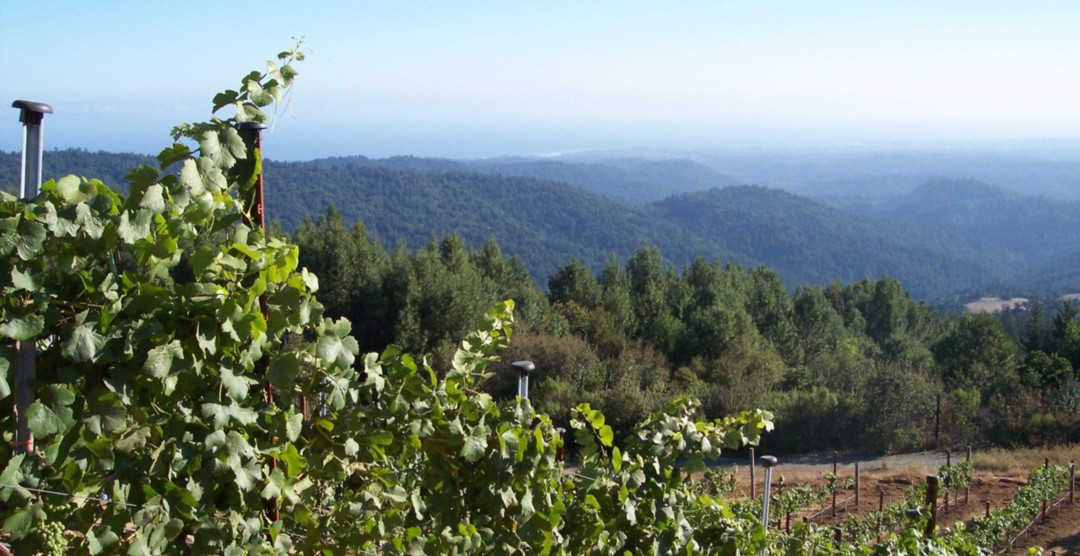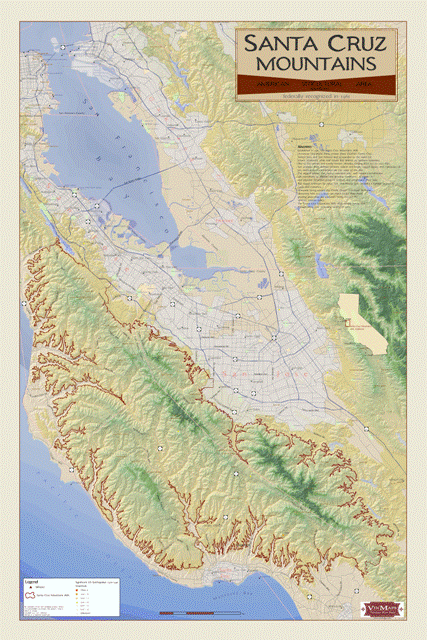Discover Santa Cruz Mountains Wine Country
Misty fog. Ocean breezes. Surf and sand. Intimate, artisan wineries. And mountain vineyards.
This is the Santa Cruz Mountains.

Fact Sheet / Backgrounder / History / TTB Definition / SubRegions
|
The Santa Cruz Mountains has played a pivotal role in the history of winemaking in California, with roots going back over 100 years, and including well-known winemakers such as Paul Masson, Martin Ray, David Bennion (Ridge), David Bruce and others. The appellation has seen significant growth and change since the start of the 21st century: in the space of a few years the number of wineries has grown from 40 to now over 60, and vineyards are proliferating. The precedence set by these legendary figures (along with best and sustainable practices in the vineyards and wineries) can be tasted today in our world-class wines. Recognized as an AVA in 1981, the Santa Cruz Mountains Appellation was among the first to be defined by its mountain topography, following the fog line along the coast to encompass our highest vineyards on the ridgetops at 2600’ elevation. Our vineyards and wineries and the wines they produce reflect this mountain terrain, and their proximity to the ocean and the resulting maritime climate. The appellation is characterized by intimate, artisan wineries tucked in among the trees along beautiful mountain roads, or perched atop the ridges with sweeping views into the valleys or along the coast. Visitors can meet with and talk with the winemakers and enjoy exploring the mountain and coastal ambience and little towns. Wine tasting here is as much a discovery of the natural beauty of the mountains as it is a delightful discovery of our world-class wines. Visitors can taste at several nearby wineries in a day, and drive from the mountaintops (where it snows in winter!) to the coast and enjoy a sunset walk on the beach! The appellation encompasses some 480,000 acres, from Woodside in the north to Watsonville (Mount Madonna) in the south, some 60 miles as the crow flies and 100 miles to drive. Within this area are some 60+ wineries and over 200 small vineyards totaling only app. 1300 acres of winegrapes, divided about ¼ evenly among Pinot Noir, Cabernet Sauvignon, Chardonnay, and ‘other’ varietals (most notably Merlot and Zinfandel). A single vineyard in some appellations has as much if not more acreage as we have in our entire appellation! Our winegrapes are rare and in demand. Our broad region is marked by diverse microclimates: warm on the eastern (inland) side where Zinfandel, Cabernet, and Merlot predominate; and on the coastal side and ridgetops, cooled by ocean breezes and fog, cooler climate varietals such as Pinot Noir are grown. Soils are varied (decomposed rock, clay, loam, limestone); an abundant mineral content often releases a fresh, mineral character to the wines. The region’s vineyards actively support sustainable winegrape growing. The Viticulture Assn. has stressed best vineyard and sustainable practices, including cover crops, erosion control, canopy management, etc. Since the first sustainable workshops in 2004 the region has seen an increase in the adoption of sustainable vineyard practices. Some have adopted alternative energy such as solar and biodiesel. Several vineyards grow organically, and one is certified organic by the CCOF. Santa Cruz Mountains wines reflect our special mountain terroir and, notwithstanding the different varietals and winemakers, typically are known for their minerality and balanced acidity, their complex flavors and long finish, and their ability to age. The result is wine that pairs particularly well with complementary foods, and age worthy wine that matures and improves in the bottle. For more information on the wineries: SCMWA, 831-685-8463 See an enlarged map of the AVA here. Map with permission of VinMaps
|

